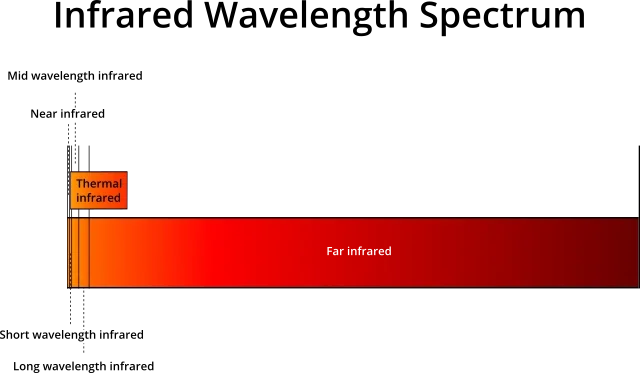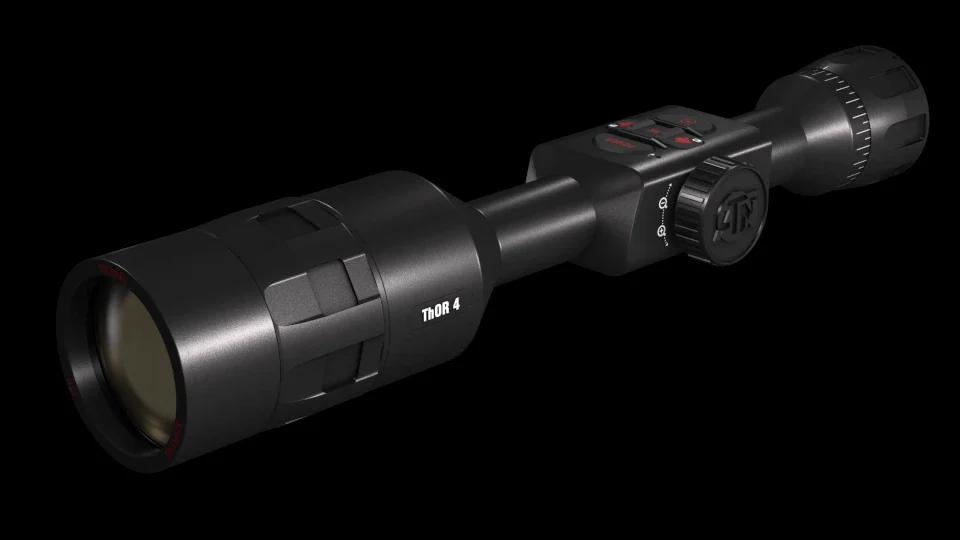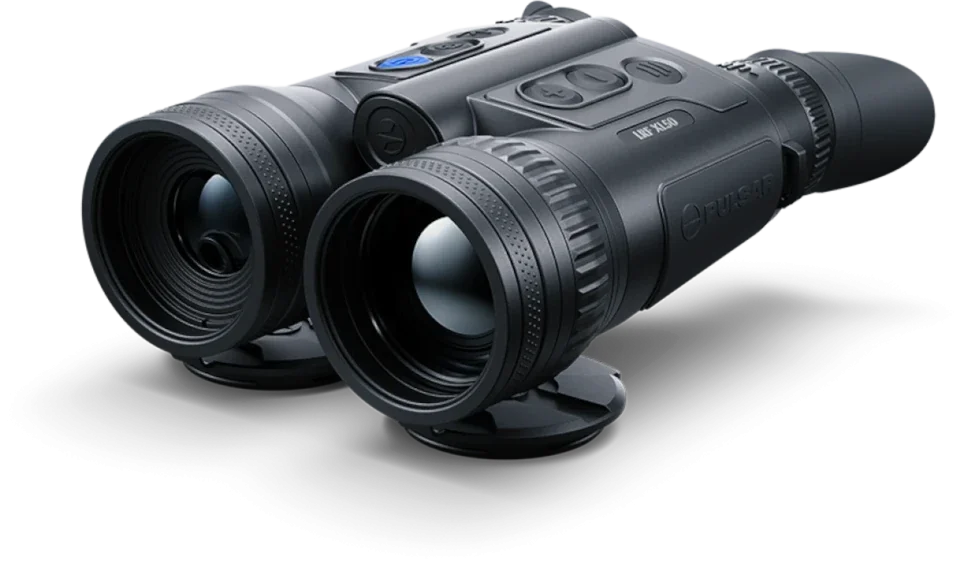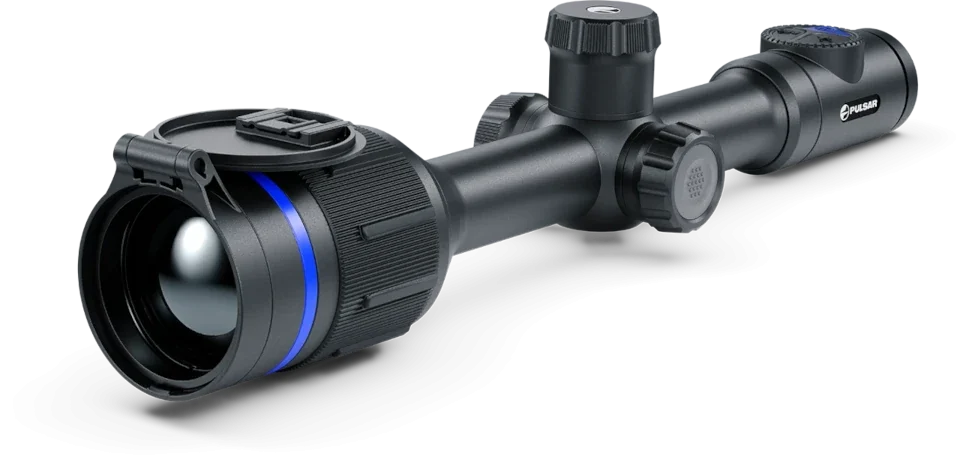

Thermal Vision
Thermal Vision allows you to see in the dark, total, can’t see the hand in front of your face dark. Unlike night vision, you can also use these devices in daylight.
Table of Contents
Thermal Vision is a optoelectrical device containing a compact thermographic camera, and can be used in a variety of manners from goggles and binoculars to rifle scopes. Capturing and analyzing the data the cameras provide is called thermography, which uses the non visible light spectrum called infrared.
Description
Thermal vision devices can operate in total darkness, and can be quite useful in places with cold nights as the extreme difference in temperatures between the cold ground and any source of heat (such as a feral pig) creates a high visual contrast between the two. This makes it easy to locate any source of heat against its low-temperature background.
Thermal has an added bonus feature of ignoring light scrub and foliage as well as ignoring dust, mist and fog.
Light wavelength units of measurement
- 1 micron (µm) = 1 micrometer = one millionth of a metre (m)= one thousandth of a millimeter (mm)
- 1 nanometer (nm) = one thousandth of a micron (μm) = one billionth of a meter (m)
- 1 Ångström (Å) = 10 nanometer (nm) =10 billionths of a meter (m)
Visible Light
Humans can see visible light in the range of 400 nanometer (nm) or 0.4 micron (μm) “Violet” to 700 nanometer (nm) or 0.7 micron (μm) “Dark Red”.

Infrared Light
We, as humans, can detect infrared waves as heat but we cannot see them.
The region that the infrared spectrum operates is in wavelengths from 0.78 to over 1000 microns (µm). This region is divided in to classes.
Table of Infrared Light Categories
| Name | Range start in microns (µm) | Range end in microns (µm) |
|---|---|---|
| Near infrared | 0.78 | 1.4 |
| Short wavelength infrared | 1.4 | 3 |
| Mid wavelength infrared | 3 | 8 |
| Long wavelength infrared | 8 | 15 |
| Far infrared | 15 | > 1000 |
Near infrared is called “near” because it is closest to the visible light spectrum.

The remote control on a TV operates just inside this invisible part of the spectrum to allow us change channels with infrared waves of light.
Thermal Vision
Thermal vision is facilitated by a camera, known variously as a:
- thermographic camera
- infrared camera
- thermal imaging camera
- thermal camera
- thermal imager
These devices create an image using light waves in the infrared part of the light spectrum.
Infrared cameras are sensitive to wavelengths from about 1,000 nm or 1 micron (μm) to about 14,000 nm or 14 micron (μm). This covers the thermal part of the infrared spectrum, which has wavelengths ranging from 3 micron (μm) to over 30 micron (μm).
Thermal Vision Device Operational Process
- The thermal infrared image is delivered through the objective lens of the thermal imaging device.
- A phased array of detector elements create a pattern called a temperature difference map or thermogram in high definition.
- The thermogram is changed into electrical impulses.
- The impulses are processed by a computer chip and made into data.
- The resulting data is displayed on a screen in the form of a visible image.

Most thermal-imaging devices scan at a rate of 30 times per second.
Thermal Vision Device Enhancements
Because a thermal vision device is basically digital, this allows for a raft of enhancements made possible by the onboard microchip. These can include:
- Brightness and contrast controls
- Image color settings
- Display enhancements like the time, battery charge level, notifications
- Digital zoom
- Picture in picture
- The ability to turn the display off ( Saves battery)
- Reticle selection
- Wind adjustment
- One shot zeroing
- Freeze zeroing
- Distance correction
- Side tilt indication
- Elevation angle
- Altitude
- Multiple rifle profiles
- Ballistic calculator
- Shot recorder
Connectivity via radio, wifi and bluetooth giving access to laser rangefinders, GPS and data transmission and reception. Have a look at the Thor 4 from ATN:

Thermal Vision Temperature Range
Most devices can detect temperatures ranging from -20 degrees Celsius (-4 degrees Fahrenheit) to 2,000 degrees Celsius (3,600 degrees Fahrenheit), and can normally detect temperature changes of approximately 0.2 degrees Celsius (0.4 degrees Fahrenheit).
History
The beginnings of heat differentiation or thermography is known to have dated back at 4,500 years ago with the recognition of heat and its association with human disease.
In whatever part of the body excess of heat or cold is felt, the disease is there to be discovered.
Hippocrates
1800
Below the red
Royal Astronomer to King George III, Sir William Hershel, was experimenting with prisms to separate the various colors of the rainbow. He discovered an invisible spectrum of light. Infrared, which mean “below the red.”
1929
The first camera
The first camera sensitive to infrared was invented by a Hungarian physicist named Kalman Tihanyi.
1947
Camera taking still images
A camera was invented that would take still images, but took an hour to produce just one photo.
1970
1st Thermal imager used fighting fires
Phillips and English Electric Valve develop the first naval thermal imager used by the Royal Navy for firefighting.
1980's
Microbolometer
Microbolometer technology developed.
Thermal Vision Pros and Cons vs. Night Vision
Pro's
- Works in daylight as well as night
- Can see through fog, dust and smoke
- Can see through foliage
Con's
- More expensive
- Heavier
- Narrower field of view
- Less natural image
Summary: Thermal vision devices are pricier than night vision as well as heavier. They do come with a raft of benefits however. The ability to be used in all light conditions and be able to see through scrub and airborne particles to name a few.
Australian Rules and Regulations
Thermal Vision Devices are legal in Australia. However states have their own regulations on their use. New South Wales does not allow the use of thermal vision when hunting in their state forests and Victoria classifies thermal vision devices as spotlights and there are hunting restrictions applicable.
Thermal Vision Devices
Hunters have been quick to take up with thermal vision devices have as prices have come down. The technology can offer tremendous benefits to a wide variety of applications.
FAQ (Frequently Asked Questions)
How do thermal scopes work?
Thermal scopes operate with an infrared camera which detects heat from the thermal part of the infrared spectrum. Heat is emitted from an object at the atomic level. This is processed and delivered to the viewer in visible light.
Is thermal vision legal in Australia?
Thermal vision devices are legal in Australia. However states have their own regulations on their use. Some states do not allow the use of thermal vision devices when hunting on certain public lands and some put thermal vision devices in the same class as spotlights and are likewise restricted for same circumstances.
According to the Australian Customs and Border Protection Service, it is illegal to import thermal vision devices without a permit. Permits may be granted for the import of thermal vision devices for certain purposes, such as scientific research, education, and testing.
Can you use thermal vision in complete darkness?
Yes, as the thermal vision camera detects emitted heat then it can function in complete darkness. An advantage over night vision devices (NVD’s).
How far can you see with thermal vision?
The distance at which you can see with thermal vision can vary depending on a number of things, such as the type of device, the temperature differentiation between the background and target, and the size and heat signature of the target. Thermal vision does not have the resolution of a normal daytime optic. ATN quote a visual range on some of their devices at 3,000 yards but the identification range is a good deal less.
Photo Credits: Pulsar, ATN

